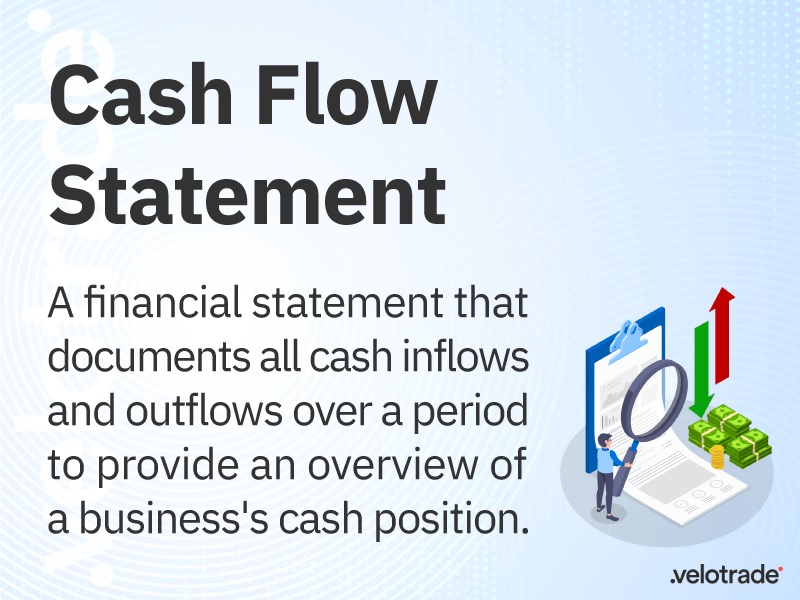
Grow Your Business Faster by Mastering Assets, Liabilities, and Equity
October 8, 2024
Retirement Riches: The Best Self-Employed Plans Revealed (Solo 401k, Solo Roth 401k, Roth IRA, SEP IRA)
November 8, 2024Learn Cash Flow Statement Essentials
Cash flow is vital for assessing a business’s financial strength, from startups to global corporations. By understanding how money moves in and out of an organization, business leaders can make informed decisions that support long-term growth and stability. Here’s everything you need to know to get started with cash flow statements.
Introduction to Cash Flow Statements
In finance, cash flow statements offer essential insights into a company’s financial health, showing exactly where cash is generated and spent. While the balance sheet and income statement provide information on assets and profitability, respectively, cash flow statements reveal the liquidity position, helping to determine a company’s ability to cover expenses and invest in future growth.
Understanding the Basics of Cash Flow
Let’s delve into the fundamentals of cash flow, including its components, methods of preparation, and why it’s indispensable for business operations.
What is a Cash Flow Statement?
A cash flow statement is a financial report that tracks cash generated or used by a business within a given period. It shows the inflows and outflows across three main sections:
- Operating Activities: Cash flows from core business operations.
- Investing Activities: Cash from investments in assets, like machinery or buildings.
- Financing Activities: Cash from debt, equity, or dividends.
Each section highlights specific areas of a company’s financial performance, providing an overall view of its cash position.
Importance of Cash Flow Statements
Cash flow statements are fundamental for businesses because they show liquidity and help in evaluating whether a business can meet its short-term obligations.
- For Managers: Helps in budgeting, planning, and maintaining liquidity.
- For Investors: Indicates potential returns and helps assess risk.
- For Creditors: Determines creditworthiness and repayment capacity.
Components of a Cash Flow Statement
The three sections of a cash flow statement give a complete picture of cash sources and uses:
- Operating Cash Flow: Captures revenue from daily operations.
- Investing Cash Flow: Shows investments in long-term assets.
- Financing Cash Flow: Details funds raised or paid back.
Each part reveals unique insights about how well a business manages its cash resources.
Analyzing Cash Flow Statements
A cash flow statement provides a deeper understanding when analyzed in parts. Here’s how to interpret each section:
- Operating Cash Flow: A positive operating cash flow indicates that a business generates enough cash from its core operations.
- Investing Cash Flow: Negative investing cash flow could indicate reinvestment in the business, such as purchasing new equipment.
- Financing Cash Flow: Shows how the company is funded. Frequent reliance on debt may indicate a need for additional capital.

Cash Flow vs. Profit
While profit is often a measure of success, it doesn’t necessarily equate to cash availability. Profit refers to revenue minus expenses, whereas cash flow focuses on the actual movement of cash within a business. A profitable business can still face cash flow issues if revenues are tied up in receivables or inventory. Understanding the distinction between cash flow and profit is critical for sound financial planning.
Step-by-Step Guide to Building a Cash Flow Statement
Preparing a cash flow statement requires a systematic approach to ensure all cash transactions are accurately recorded. Here’s a step-by-step breakdown:
- Gather Financial Data: Start by collecting data from the income statement and balance sheet. The income statement provides revenue and expenses, while the balance sheet shows changes in assets, liabilities, and equity.
- Calculate Operating Activities: Adjust net income by adding or subtracting non-cash items, such as depreciation and changes in working capital, to calculate cash generated from operating activities.
- Calculate Investing Activities: Record cash used for purchasing or selling assets. This includes acquisitions of long-term assets, proceeds from sales, and changes in investments.
- Calculate Financing Activities: Include cash inflows from issuing debt or equity and outflows from repaying debt, paying dividends, or repurchasing stock.
- Finalize the Cash Flow Statement: Summarize the total cash flows from each activity, add the beginning cash balance, and confirm that the ending cash matches the balance sheet’s cash position.
Practical Examples of Cash Flow Statements
Examining real-world examples can clarify how cash flow statements are structured:
- Small Business Example: A small business might have straightforward cash flows, focusing primarily on operating and investing activities. This example helps to demonstrate typical cash transactions for small, owner-managed firms.
- Corporate Example: Large corporations have complex cash flow statements involving substantial transactions in all sections. This example highlights how large companies balance cash flows between operations, investments, and financing.

Common Cash Flow Statement Mistakes and Solutions
Creating a cash flow statement can be prone to certain errors, which may distort the financial picture:
- Common Mistakes:
- Double-Counting: Adding the same cash inflows or outflows in multiple sections.
- Incorrect Classification: Misplacing activities, like including investing activities in operating cash flow.
- Ignoring Non-Cash Adjustments: Forgetting to add back non-cash expenses like depreciation to operating activities.
- Solutions:
- Cross-Check Entries: Regularly cross-check entries against the income statement and balance sheet.
- Use Templates: Many financial software and spreadsheet templates help reduce errors.
- Stay Consistent: Use consistent classification to maintain accuracy.
Cash Flow Analysis Ratios
Analyzing cash flow ratios provides insights into a company’s operational efficiency and financial health. Here are some key ratios:
- Operating Cash Flow Ratio: Measures if a company can pay its short-term liabilities with cash from operations.
- Formula: Operating Cash Flow / Current Liabilities
- Free Cash Flow to Firm (FCFF): Indicates the cash a company generates after accounting for capital expenditures, useful for evaluating reinvestment potential.
- Formula: Operating Cash Flow – Capital Expenditures
- Cash Flow Margin Ratio: Shows the proportion of cash flow relative to sales, reflecting cash efficiency.
- Formula: Operating Cash Flow / Net Sales
- Cash Flow Coverage Ratio: Assesses a company’s ability to cover debts using cash flow from operations, crucial for creditors.
- Formula: Operating Cash Flow / Total Debt
Cash Flow Statement and Financial Health
Cash flow statements directly indicate financial stability and future prospects:
- Financial Stability: Consistent positive cash flow from operations suggests resilience, as it indicates the company can meet operational expenses.
- Future Planning: Cash flow forecasting and budgeting enable businesses to prepare for growth or downturns, manage liquidity, and make informed investment decisions.
- Investor Perspective: Investors view cash flow statements to assess risk, particularly in terms of dividend payouts, debt levels, and operational efficiency.
Digital Tools for Cash Flow Management
In the digital age, managing cash flow has become more streamlined with specialized tools and templates:
- Best Software for Cash Flow Tracking: Tools like QuickBooks, Xero, and FreshBooks provide features for real-time tracking, forecasting, and reporting.
- Tips for Using Excel for Cash Flow: Excel remains popular for cash flow management, offering templates and formulas for easy customization. Financial functions like SUMIF and IFERROR allow for efficient data processing.
Frequently Asked Questions (FAQs)
What is the purpose of a cash flow statement?
A cash flow statement shows a company’s cash inflows and outflows, helping to assess liquidity and financial flexibility.
How is a cash flow statement different from an income statement?
While an income statement records revenue and expenses, a cash flow statement tracks the actual movement of cash, highlighting liquidity.
What are common cash flow statement errors?
Errors include double-counting, incorrect classification of cash flows, and failure to adjust for non-cash items.
How often should cash flow statements be prepared?
Cash flow statements are typically prepared quarterly and annually, but some businesses monitor cash flow monthly.
Why is cash flow analysis important for investors?
Investors use cash flow analysis to assess a company’s financial health, growth potential, and ability to generate returns.
What is the difference between free cash flow and net cash flow?
Free cash flow refers to cash after capital expenditures, while net cash flow is the overall cash balance change within a period.
Conclusion: Mastering Cash Flow Statement Essentials
Understanding and managing cash flow is crucial for any business’s financial health. A well-prepared cash flow statement not only supports day-to-day operations but also aids in long-term financial planning and investment decision-making. By mastering the essentials, you’ll gain valuable insights into the company’s ability to grow sustainably and maintain stability.
Resources
Official Guide on Cash Flow Statements by the Financial Accounting Standards Board (FASB)
- Provides authoritative guidance on financial reporting, including cash flow statement standards and structure.
Using QuickBooks to Track Cash Flow
- How businesses can utilize QuickBooks software for cash flow tracking, useful for those seeking digital tools for cash flow management.
Investopedia’s Guide to Free Cash Flow (FCF)
- Offers a thorough explanation of Free Cash Flow, including its calculation and importance in cash flow analysis, to supplement the article’s section on financial ratios.
DISCLAIMER: The information in this article is for informational purposes only and is not meant to take the place of legal and accounting advice.




